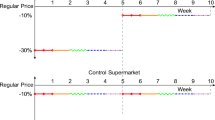Abstract
We summarize and critique seven theories that might explain the lack of a postpromotion dip in sales in the weeks following a promotion. We then propose and provide empirical support for a new explanation. We argue that in markets where the consumer category purchase decision is not strongly influenced by inventory levels, the displacement effect of accelerated sales will tend to be distributed fairly uniformly into the future such that clearly defined dips are not observed. We utilize a simulation based on real data to investigate this explanation. The simulation shows that given the degree to which inventory influences the purchase decision, we would not expect to see postpromotion dips, even though promotion influences the purchase decision. However, the simulation shows that if inventory had a greater influence on the purchase decision, we would expect to see postpromotion dips. We conclude with implications for both researchers and managers.
Similar content being viewed by others
References
Abraham, Magid M., and Leonard M. Lodish. (1993). “An Implemented System for Improving Promotion Productivity Using Store Scanner Data.”Marketing Science 12, 248–269.
Assunção, Joao L., and Robert L. Meyer. (1993). “The Rational Effect of Price Promotions on Sales and Consumption.”Management Science 39, 517–535.
Bawa, Kapil, and Robert W. Shoemaker. (1987). “The Coupon-Prone Consumer: Some Findings Based on Purchase Behavior Across Product Classes.”Journal of Marketing 51, 99–110.
Blattberg, Robert C., Gary D. Eppen, and Joshua Lieberman. (1981). “A Theoretical and Empirical Evaluation of Price Deals for Consumer Nondurables.”Journal of Marketing 45, 116–129.
Blattberg, Robert C., and Scott A. Neslin. (1989). “Sales Promotion: The Long and the Short of It.”Marketing Letters 1, 81–97.
Blattberg, Robert C., and Scott A. Neslin. (1990).Sales Promotion Concepts, Methods, and Strategies. Englewood Cliffs, NJ: Prentice-Hall.
Blattberg, Robert C., and Kenneth J. Wisniewski. (1989). “Price-Induced Patterns of Competition.”Marketing Science 8, 291–309.
Bucklin, Randolph E., and James M. Lattin. (1991). “A Two-State Model of Purchase Incidence and Brand Choice.”Marketing Science 10, 24–39.
Chiang, Jeongwen. (1995). “Competing Coupon Promotions and Category Sales”.Marketing Science, 14, 105–122.
Currim, Imran S., and Linda G. Schneider. (1991). “A Taxonomy of Consumer Purchase Strategies in a Promotion Inensive Environment.”Marketing Science 10, 91–110.
Dodson, Joe A., Alice M. Tybout, and Brain Sternthal. (1978). “Impact of Deals and Deal Retraction on Brand Switching”Journal of Marketing Research 15, 72–81.
Ehrenberg, A.S.C., Kathy Hammond, and G.J. Goodhardt. (1994). “The After-Effects of Price-Related Consumer Promotions.”Journal of Advertising Research (July–August), 11–21.
Farris, Paul W., and John A. Quelch. (1987). “In Defense of Price Promotion.”Sloan Management Review (Fall), 63–69.
Goldstein, David K. (1993). “Product Manager's Use of Scanner Data: A Story of Organizational Learning.” M.S.I. Working paper 93-109, Marketing Science Institute, Cambridge, MA.
Grover, Rajiv, and V. Srinivasan. (1992). “Evaluating the Multiple Effects of Retail Promotions on Brand Loyal and Brand Switching Segments.”Journal of Marketing Research 29, 76–89.
Gupta, Sunil (1988). “Impact of Sales Promotions on When, What, and How Much to Buy.”Journal of Marketing Research 25, 342–355.
Gupta, Sunil. (1991). “Stochastic Models of Interpurchase Time with Time-Dependent Covariates.”Journal of Marketing Research 28, 1–15.
Guadagni, Peter M., and John D.C. Little. (1983). “A Logit Model of Branch Choice Calibrated on Scanner Data.”Marketing Science 2, 203–238.
Krishna, Aradhna. (1992). “The Normative Impact of Consumer Price Expectations for Multiple Brands on Consumer Purchase Behavior.”Marketing Science 11, 266–286.
Krishna, Aradhna, Imran S. Currim, and Robert W. Shoemaker. (1991). “Consumer Perceptions of Promotional Activity.”Journal of Marketing 55, 4–16.
Moriarty, Mark. (1985). “Retail Promotional Effects on Intra- and Interbrand Sales Performance.”Journal of Retailing 6, 27–48
Narasimhan, Chakravarthi. (1984). “A Price Discrimination Theory of Coupons.”Marketing Science 3, 128–147.
Neslin, Scott A., Caroline Henderson, and John Quelch. (1985). “Consumer Promotions and Acceleration of Product Purchases.”Marketing Science 4, 147–165.
Neslin, Scott A., And Robert W. Shoemaker. (1983). “A Model for Evaluating the Profitability of Coupon Promotion.”Marketing Science 2, 361–388.
Pedrick, James H. (1987). “Modeling Deal Effects Using Scanner Panel Data.” Working paper, Graduate School of Business, University of Chicago.
Scott, Carol A. (1976). “The Effects of Trial and Incentives on Repeat Rate of Deal Purchases.”Journal of Marketing Research 13, 263–269.
Shoemaker, Robert W. (1979). “An Analysis of Consumer Reactions to Product Promotions.” In Neil Beckwith, Michael Houston, Robert Mittelstaedt, Kent B. Monroe, and Scott Ward (eds.).Educators' Conference Proceedings (pp. 244–248). Chicago: American Marketing Association.
Tellis, Gerard, and Fred Zufryden. (1995). “Tackling the Retailer Decision Maze: Which Brands to Discount, How Much, When and Why?”Marketing Science, 14, 271–299.
Totten, John C., and Leigh McAlister. (1985). “Decomposing the Promotional Bump: Switching, Stockpiling and Consumption Increase.” Paper presented at the ORSA/TIMS Joint National Meeting, November.
Wansink, Brian, and Rohit Deshpandé. (1994). “Out of Sight, Out of Mind: Pantry Stockpiling and Brand-Usage Frequency.”Marketing Letters 5, 91–100.
Wittink, Dick R., Michael J. Addona, William J. Hawkes, and John C. Porter. (1987). “SCAN-PRO: A Model to Measure Short-Term Effects of Promotional Activities on Brand Sales, Based on Store-Level Scanner Data.” Working paper, Johnson Graduate School of Management, Cornell University, Ithaca, NY.
Author information
Authors and Affiliations
Rights and permissions
About this article
Cite this article
Neslin, S.A., Schneider Stone, L.G. Consumer inventory sensitivity and the postpromotion dip. Market Lett 7, 77–94 (1996). https://doi.org/10.1007/BF00557313
Issue Date:
DOI: https://doi.org/10.1007/BF00557313




